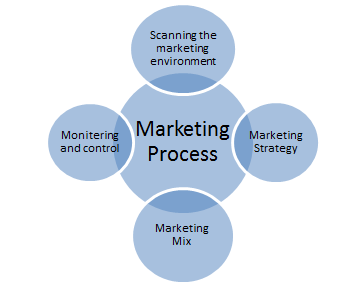- support@locusassignments.com
Unit 4 Marketing Principles Assignment Copy

|
Programme |
Diploma in Business (Marketing) |
|
Unit Number and Title |
Unit 4 Marketing Principles |
|
QFC Level |
Level 4 |
Introduction
Marketing is the most crucial part of the organisation. It is one activity on which the complete existence of the business is dependent (Jobber & Ellis-Chadwick, 2012). Companies these days small or big have to adopt adequate marketing strategies in order to sustain in the market for long period of time. The report will discuss in detail about various marketing principles which are important for the business.

Task 1
Part 1: Two alternative definition of marketing
The Chartered Institute of Marketing (CIM)
According to the chartered institute of marketing (CIM), Marketing is the management process which is responsible for identifying, anticipating and satisfying customer requirements profitability (Jobber & Ellis-Chadwick, 2012).
This definition can be explained further by stating marketing as the bunch of many ideas, the brand or the way to communicate or the design, process of print and also measurement of the effectiveness of the marketing program, market research and the basic psychology behind the consumer behaviour of all kinds which is also the part of the bigger picture of marketing (Jobber & Ellis-Chadwick, 2012). Marketing essentials is basically related to the understanding of what usually people wants and it is also related to the needs and preferences of the consumer. Being in the business and the motive to succeed in the market, it is very important for the organisation to understand the need and wants of the customers which can help in adding the value in the sales through structured marketing activities in order to achieve success in the business in the long run (Jobber & Ellis-Chadwick, 2012).
The weakness of the statement defined by the chartered institute of marketing is that the definition has narrowed the limit of the marketing whereas scope of marketing is much wider and it includes a lot of activities besides identifying and attracting the market and it also includes sustaining in the market in the long run (Jobber & Ellis-Chadwick, 2012).
The American Marketing Association: According to the American Marketing Association marketing activity are not just an activity but set of institutions and also the processes in order to create, communicate, deliver and also exchange which help in offering which have values for the customers, clients or partners and it also include society on the larger frame (Kotler & Armstrong, 2013).
According to this definition, the marketing is the function which links the consumer or customers or public to the marketing executives through series of information which used to identify and defines opportunities related to marketing and also the issues which help in generating, refining and evaluating actions in marketing and also monitor the performance of the marketing and improving the understating of marketing which can be treated as a process (Kotler & Armstrong, 2013). The definition is also important from information point of view which requires addressing the issues, designs the ways for collecting the important information, manages and also implements the collection of data process, analyse the results which are crucial for the company and also communicate in the proper manner which are the finding of the research and its implications (Kotler & Armstrong, 2013).
Part 2: elements of marketing process
Following is the diagrammatical representation of the market process: -

- Scanning the marketing environment: - it is important to have a through scanning of the situation in which the company is functioning. The company anyways has to identify the customer suited for the organisation and in addition to that the company will also have to understand its own strengths and the overall business environment in which the company is operating (Kotler & Armstrong, 2013). The analysis of situation includes many elements like present, past and the future aspects. This way the company will able to understand that whether there is any gap in the actual customer needs and the actual offering to the customer. In case there is any gap in both the situation then it can be filled immediately. This can be done by using various methods like 5 C analysis, PEST analysis and SWOT analysis (Kotler & Armstrong, 2013). Here the example will be taken of McDonalds which is one of the largest fast food chains in the world. The company have to function in various marketing environment and it is a best example to understand how a multinational company have to modify themselves in various market situations and as per the change in the environment. McDonalds first do a proper market research where the company try to understand the customer needs and preferences. The company than bring some significant changes in the menu which suit the local taste and preferences (Kotler & Armstrong, 2013).
- Marketing strategy: - once the situation is analysed properly and the company is able to identify the customer needs which are yet to be filled, than a proper marketing strategy is formulated in order to serve the needs in a proper manner. Analysis and the market research will help in identifying the target market and a strategy will be formed in order to position the product properly (Struthers, 2014). In case of McDonalds, the first target group which generally get attracted to the brands are children and the company have introduced so many things like Happy Meals in order to attract maximum number of children (Struthers, 2014).
- Marketing mix: - after defining the segmented market and positioning the product, detailed tactical decision are then are made and the best parameter used for this is marketing mix. McDonalds is involved in product development, pricing decisions, distribution contracts, and promotional campaign for the development (Struthers, 2014).
- Monitoring and control: - at this stage marketing plan has been developed and there is a proper launch of the product. Here, the marketing manager has to bear in mind that the environment constantly changes and the company will have to take decisions as per that (Struthers, 2014).
Question 2: Marketing orientation
Marketing orientation is more related to decision making methods and scenarios. It also includes marketing intelligence, analyses of the culture based behaviour pattern and also the customer orientation perspective (Struthers, 2014). Market orientation can be defined as the combination of market intelligence, dissemination of this intelligence and other information across the departments and various organisations responding to it. It can be further defines as an actual and real implementation of the various marketing concepts and principles. In addition to that, the culture of an organisation is usually affected by effectively and efficiently creating the important workforce and defined set behaviour in order to create the superior value for the buyers which will further results in the superior form of performance for the business point of view (Struthers, 2014). Market orientation consists of three basic behaviour elements like customer orientation, competitor’s orientation and also coordination which are inter-functional. Following is the detailed discussion of product orientation and sales orientation: -
- Product orientation: a company which is product oriented is the one which believes that the product should be of very high quality and what makes it superior is its functional features (Jung et al, 2013). These companies maintained very high quality as far as product is concerned and this way people automatically started liking the product and will buy it for the quality for the product. The main issue with this approach is that it is dependent on superiority alone and it is important to understand that it can be solo reason for selling the products (Jung et al, 2013). It is also important to understand the want and need of the product. Companies like Apple and Sony etc.
- Sales orientation: A company which is based on sales is the company which has a simple focus. The main strategy is to make the product, and then sell it in the target market (Jung et al, 2013). This type is basically based on the organisation that manufacture products which are based on customer needs and these products are made after much needed research and after collecting relevant information. Here sales is usually is not very simple and an effective marketing strategy is required and market and marketing research is also very important (Jung et al, 2013).
Benefits and cost of market orientation
Benefits of the market orientation
- The market orientation approach helps in eliminating the guessing and also forecasting which is related to the attempt of predicting the trends which is prevailing in the market. It is also related with the consumer demand of the goods and services (Jung et al, 2013). When the customers are expressive in terms of their needs and wants, the company is able offer which that easily. This way the company can easily streamline the product and development around it and also lower the cost which goes in the creativity and innovation.
- These also help in increasing the loyalty among the customers and develop a customer base which readily uses the product number of times. Brand loyalty is very important and it alone helps in building the large customer base (Weinstein, 2013). It also helps in the getting a competitor edge in the market and the customer become more resistant and indifferent to what competitors are doing.
Cost of market orientation
- In order to implement the market orientation plan effectively, the company usually have to invest in extensive and aggressive marketing research. It is also very important to understand the market and keep a watch at the customer needs and changing trends and constantly develop a product which suits the needs of the customer (Weinstein, 2013). For that the company will have to conduct constant research which takes times and also require professionals which can be very expensive affair.
- Increasing the value for the customer base can also increase the production costs of the goods and services. Like for example, choosing the warranties for the product as a response of consumer demand which require company to have a staff which help to make repairs or hire a company which handles all the maintenance related to warranty. This automatically raises the cost which can prove to be a big loss and which can cost in proving a success in the market (Weinstein, 2013).
Contact us
Get assignment help from full time dedicated experts of Locus assignments.
Call us: +44 – 7497 786 317
Email: support@locusassignments.com
Task 3
3.1 Describe the macro environmental elements that would influence Sainsbury in its selection of an international market for business expansio
Micro and macro environment is the part of market environment which is a marketing term and also refers to the factors and also some forces that affect the ability of the organisation and also build and maintain a successful relationship with the customers. There are two types of environment which is micro and macro environment (C?toiu et al, 2013). Micro environment can be defined as small forces in the company that can be responsible to affect the customer base. Macro environment mean a company operates in an industry and the forces are larger forces from society and it affects microenvironment. Following is the PESTLE analysis of company Sainsbury: -
- Political forces: these are European Union extensions, Euro Zone, Globalise business, taxation rules and also the policies. Sainsbury is forced by the factors discussed here and it is important to analyse each and every factors (C?toiu et al, 2013).
- Economic forces: - the change in term of economic under any government impact the local business and it includes interest rates, charges of taxation, economic growth, inflation and exchange rates. The company is obviously affected by these factors (C?toiu et al, 2013).
- Social forces: - it is crucial for any business to understand the value and the culture of the society much before starting the business. It may include taste, habits, tradition, demographics etc. In Sainsbury these factors are very important as it include charities, sponsoring, arranging social activities and raising funds etc. (C?toiu et al, 2013).
- Technological forces: Many technologies are being created daily which results in new products and processes. There are many developments which can benefits consumers as well as organisations which are providing the products can prove too revolutionary in nature. The company run the business because of better technology (C?toiu et al, 2013).
- Environmental forces: - these forces include changing the weather and the climate of the business. With the recent changes in the climate that occurs mainly due global warming and many other issues, it is becoming a crucial issue to discuss and consider (C?toiu et al, 2013).
- Legal forces: the company is in the boundaries of legal forces which are present locally, nationally and globally.
How international markets differ from domestic?
Following is the detailed discussion of domestic and international business: -
- Couture: - it is obvious that no two cultures are similar in nature and it defines everything a society performs. For domestic market it is easier to understand the market and for international business it is important to understand the culture they are entering (French, 2010).
- Level of competition: the level of competition defers for both type of businesses. For domestic market the level of competition is lower in comparison to international market (French, 2010).
- Market intelligence: the important point which every business is gathering for market intelligence understands how a market works, direct competition and the best market strategy which affect the entry (French, 2010).
Importance of the 4Ps of the marketing mix: The marketing and sales section in any business constantly struggles to devise a right marketing formula for a business (French, 2010). There are number of factors which are responsible for the success of the marketing of the company and combination of these factors is known as marketing mix.
Marketing mix includes what price to offer and where it has to be offered and how to offer it in long run. There are basically four Ps in the marketing mix which are essential for the business and help the business to find many answers. These 4 Ps includes strategic positioning so that in return there are maximum profits in any type of market (French, 2010).
Following are the four Ps of marketing mix: -
- Product
- Price
- Place
- Promotion
The additional three Ps of the marketing mix: The additional Ps in marketing mix is very important in the service marketing and they are used to define marketing strategies for the service industries (Rudd & Mills, 2011). Following are the additional three Ps of the marketing mix.
- Process
- Physical evidence
- People
Developing products to sustain competitive advantage: Sustaining a competitive advantage is not an easy process and for this the company will have to constantly develop and update as per the change in the market. Changes are the only constant thing which exists and the company also have change as per the changes in the industry (Challagalla et al, 2014). Developing products and constantly innovating in it is an only way through which the company can sustain for long run in the market. The company will have to challenge its competencies and update it as and when required.
Conclusion
Marketing is most important element of business and something on which the business exists (Challagalla et al, 2014). The report has discussed in detail about various marketing principles and its application in the companies.
References
Challagalla, G., Murtha, B. R., & Jaworski, B. (2014). Marketing Doctrine: A Principles-Based Approach to Guiding Marketing Decision Making in Firms. Journal of Marketing.
French, J. (Ed.). (2010). Social marketing and public health: Theory and practice. Oxford University Press.
Hanekom, L. M., Gericke, G. J., & Becker, P. J. (2011). South African private practising clinical dieticians’ perceptions of the relevance of service-specific healthcare marketing principles and communication elements. South African Journal of Clinical Nutrition, 24(4), 192-198.
Jobber, D., & Ellis-Chadwick, F. (2012). Principles and practice of marketing (No. 7th). McGraw-Hill Higher Education.
Jung, S. E., Hermann, J., Parker, S., Shin, Y. H., & Phelps, J. (2013). Formative Assessment using Social Marketing Principles to Identify Rural Older Oklahomans’ Perspectives of Health. Journal of Nutrition Education and Behaviour, 45(4 Supplement).
Rudd, D., & Mills, R. (2011). Expanding Marketing Principles for the Sale of Higher Education. Contemporary Issues in Education Research (CIER), 1(3), 41-52.
Struthers, A. (2014, August). Impact of High School Based Wellness Program on Adolescent Attitudes toward Fruits, Vegetables and Physical Activity. In2014 National Conference on Health Communication, Marketing, and Media (August 19-21). CDC.
Weinstein, A. (2013). Handbook of Niche Marketing: Principles and Practice. Routledge.
Wright, S., & Cawston, J. A. (2012). The Shifting Sands of University Funding: A Values-Benefits Driven Approach to Formulating Employer Liaison Direct Marketing Activity. Why Marketing Standards?
Need Help with Your Assignment?
Get expert guidance from top professionals & submit your work with confidence.
Fast • Reliable • Expert Support
Upload NowDetails
Other Assignments
Related Solution
Other Solution


